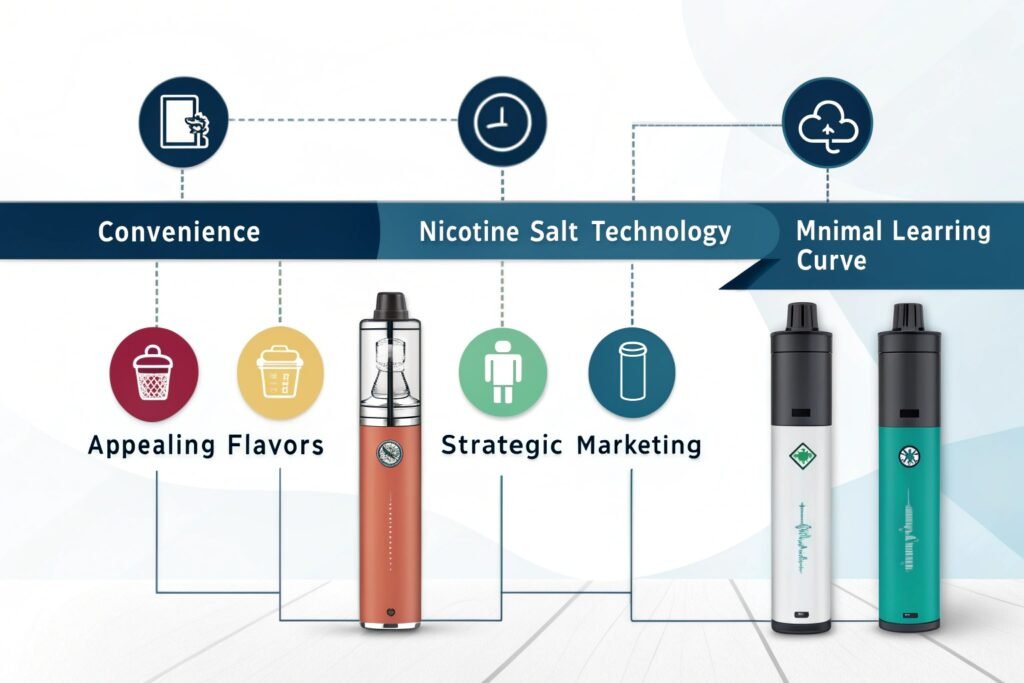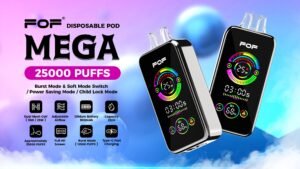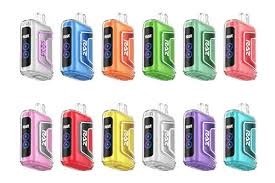The vape industry transforms faster than most people realize. I remember when my manufacturing floor produced mainly refillable systems, then seemingly overnight, disposable vape orders overwhelmed our production capacity. Distributors worldwide scrambled to secure inventory as consumer demand exploded, leaving many wondering how this rapid shift happened.
Disposable vapes became mainstream popular between 2019-2020, driven by the introduction of nicotine salt formulations, JUUL's market impact, and simplified user experience. The COVID-19 pandemic accelerated adoption as consumers sought convenient nicotine products without shared touchpoints, with global market growth exceeding 30% annually since 2020.
 Disposable Vape Popularity Timeline
Disposable Vape Popularity Timeline
As someone who's manufactured vaping products for over a decade, I've had a front-row seat to this market transformation. When Tommy first visited our factory in 2018, he was primarily interested in our refillable pod systems. By his next visit in 2020, his orders had shifted dramatically toward disposables. This pattern repeated with distributors across different markets, reflecting a fundamental shift in consumer preferences that reshaped our entire production strategy.
Why Did Disposable Vapes Become Popular?
Ever wonder why these colorful single-use devices suddenly appeared everywhere? Confused about how they overtook traditional vaping so quickly? The answer involves technological breakthroughs, consumer psychology, and perfect timing.
Disposable vapes became popular due to their unmatched convenience, the introduction of nicotine salt technology providing cigarette-like satisfaction, minimal learning curve for new users, appealing flavors in ready-to-use formats, and strategic marketing targeting smokers seeking simpler alternatives to traditional vaping devices that many found too complex.
 Evolution of Vape Device Simplicity
Evolution of Vape Device Simplicity
Having witnessed this shift from the manufacturing side, I can identify several key factors that drove the disposable vape boom:
Technological Breakthroughs That Enabled the Disposable Revolution
The disposable vape surge wouldn't have been possible without several technological developments converging at once:
Nicotine Salt Formulation
The development of nicotine salt e-liquids around 2015-2017 fundamentally changed what was possible in a small vaping device. Traditional freebase nicotine was harsh at high concentrations, limiting smaller devices' effectiveness. Nicotine salts changed everything:
- Smoother throat hit: Allowed for 50mg/ml concentrations in tiny devices without harshness
- Faster satisfaction: Delivered nicotine to the bloodstream more rapidly, mimicking cigarettes
- Longer-lasting satisfaction: Created sustained nicotine delivery similar to traditional smoking
When we first reformulated our e-liquids with nicotine salts, our test panels of former smokers reported dramatically higher satisfaction scores. Tommy noted this immediately when sampling our first disposable prototypes, commenting that they "finally felt like a proper cigarette replacement."
Battery Technology Improvements
Advances in battery technology made disposables viable:
- Higher energy density: Modern lithium-ion cells packed more power in smaller sizes
- Better discharge profiles: Maintained consistent output throughout battery life
- Lower production costs: Made single-use applications economically feasible
- Enhanced safety features: Built-in protections made them safer for consumer use
Our early disposable prototypes from 2016 had barely enough battery life for 100 puffs. By 2019, similar-sized devices could deliver 300+ puffs, and today's models can exceed 5000 puffs through battery optimizations alone.
Miniaturized Components
The size reduction of critical components enabled sleek, pocket-friendly designs:
- Smaller coil assemblies: More efficient heating with less power
- Miniaturized circuit boards: Advanced control in minimal space
- Precision wicking materials: Better liquid delivery with less material
- Integrated designs: Combined components reduced overall space requirements
When FOF vape distributor visited our R&D lab in 2020, he was amazed at the component miniaturization. We showed him how the internals of our newest disposables used 40% less space than models from just 18 months earlier while delivering better performance.
Market Forces and Consumer Psychology
Beyond technology, several market factors accelerated disposable vape adoption:
Reaction to Regulatory Complexity
As vaping regulations increased globally, consumers sought simpler alternatives:
- Complicated PMTA process1: Made many refillable products unavailable in the US
- TPD restrictions2: European regulations limited tank sizes and created filling hassles
- Regional flavor bans3: Made DIY mixing and refilling more complicated
The regulatory burden shifted consumer preference toward grab-and-go options that didn't require navigating complex compliance issues or finding compatible components.
Shift in Retail Strategies
Retail evolution favored disposables:
- C-store expansion: Convenience stores preferred simple products with minimal staff training
- Streamlined inventory: Retailers could stock complete solutions rather than components
- Higher margins: Better profit potential on single transactions versus component sales
- Reduced counterfeit concerns: Easier to verify complete products than individual components
When Tommy restructured his distribution business to focus on convenience stores rather than vape shops, he found disposables offered better inventory turnover and higher per-transaction value.
The COVID-19 Pandemic Effect
The pandemic created unexpected conditions that accelerated disposable adoption:
- Hygiene concerns: Consumers worried about sharing devices or touching components
- Supply chain disruptions: Component shortages made refillable systems less reliable
- Reduced retail interaction: Quick purchases became preferred over extended consultations
- Stress and convenience factors: Higher stress levels drove demand for convenient nicotine delivery
Our sales data showed a 215% increase in disposable orders during the first six months of the pandemic, while refillable system orders grew by only 26%.
User Experience Advantages
The disposable format solved several persistent problems for vapers and smokers:
Barrier to Entry Reduction
Disposables eliminated common obstacles for potential users:
- No technical knowledge required: Eliminated the learning curve of traditional vaping
- Zero maintenance: No coil changes, charging, or refilling necessary
- Predictable experience: Consistent performance until the device is depleted
- Immediate gratification: Ready to use immediately upon purchase
When conducting user testing, we found that former smokers could successfully use disposables with zero instructions, while refillable systems often required 5-10 minutes of guidance.
Psychological Appeal
The disposable format aligned with existing consumer behaviors:
- Cigarette-like usage pattern: Similar to opening a pack and using until empty
- Reduced psychological commitment: Lower initial investment made trying easier
- Sampling variety: Enabled trying different flavors without major investment
- Reduced "vaper identity": Appealed to those who didn't want to identify as "vapers"
I've observed that many consumers who reject the "vaper" identity readily adopt disposables because they lack the cultural associations of larger vape devices.
The convergence of these technological developments, market conditions, and user experience advantages created perfect conditions for the disposable vape boom. When JUUL demonstrated the market potential for simple pod systems, manufacturers quickly adapted the concept into fully disposable formats, creating the category we know today.
When Did Vaping Start Trending?
Looking back at vaping's journey from obscure hobby to global phenomenon? Trying to understand how these devices went mainstream? Let me take you through the evolution I've witnessed firsthand.
Vaping began trending in 2007 with early e-cigarettes, gained substantial momentum around 2012-2014 with second-generation devices, and achieved mainstream recognition in 2017-2018 when JUUL and pod systems dominated. Social media, celebrity adoption, and flavor variety fueled awareness, creating distinct waves of popularity that culminated in the current disposable-dominated market.
 Vaping Popularity Timeline
Vaping Popularity Timeline
Having witnessed the vaping industry evolve from its earliest days, I can map the distinct phases that brought us to today's market:
The Early Pioneers (2007-2011)
The first wave of vaping adoption remained relatively niche:
First-Generation Devices
The initial e-cigarette market was characterized by:
- Cigalike designs: Small devices resembling cigarettes with low battery capacity
- Limited distribution: Primarily online sales with minimal retail presence
- Low performance: Modest vapor production and inconsistent nicotine delivery
- High prices: Early adoption premium with relatively poor value proposition
When I first entered the industry in 2009, annual global e-cigarette sales were estimated at just $20 million, primarily through direct-to-consumer online channels. These early devices satisfied only the most motivated cigarette quitters, with many users returning to smoking due to performance limitations.
Early Market Structure
The business landscape during this period was fragmented:
- Patent disputes: Ongoing legal battles over fundamental technologies
- Limited standardization: Incompatible components between brands
- Small manufacturers: Production primarily by startup companies
- Minimal mainstream awareness: Little recognition outside tech-forward early adopters
I remember attending the first international vape exhibition in 2010 - the entire global industry fit in a small hotel conference room. Tommy wasn't even in the business yet, as few people saw the category's potential.
The Hobbyist Expansion (2012-2015)
The second wave represented significant growth driven by enthusiast innovation:
Technological Leaps
Major advancements fueled rapid adoption:
- Refillable tank systems4: Replaced sealed cartridges with user-fillable designs
- Variable power devices: Allowed customization of vapor production and temperature
- Standardized connections: 510 threading became the industry standard
- Improved battery life5: Higher capacity batteries enabled all-day use
- DIY culture6: User-driven innovation including coil building and liquid mixing
This period saw the rise of vape shops serving enthusiasts. Our manufacturing shifted from producing complete devices to focusing on modular components that hobbyists could customize. Industry growth rates exceeded 80% annually in many markets during this period.
Cultural Momentum
Vaping developed a distinct subculture:
- Cloud competitions: Public events showcasing vapor production skills
- Online communities: Forums and social media groups with millions of members
- Flavor exploration: Thousands of e-liquid options driving consumer interest
- Identity formation: "Vaper" became a recognized consumer identity
By 2014, vaping had developed its own vocabulary, influencers, and community practices. The activity had transitioned from merely smoking cessation to a hobby with its own appeal. Our product development increasingly responded to enthusiast feedback rather than just creating cigarette alternatives.
Mainstream Breakthrough (2016-2019)
The third wave brought vaping to the general public:
The JUUL Phenomenon
JUUL's impact on market development was profound:
- Sleek design aesthetic: Shifted from hobbyist equipment to lifestyle accessory
- Simplified experience: Pod systems eliminated technical complexity
- Nicotine salt adoption: Provided cigarette-like satisfaction in small devices
- Strategic distribution: Expanded beyond vape shops into convenience channels
- Youth appeal concerns: Created regulatory backlash and public health debates
JUUL's market capitalization reached $38 billion by late 2018, exceeding the valuation of many established tobacco companies. Their success demonstrated the massive market potential for simplified vaping products, directly inspiring the disposable category.
Celebrity and Media Influence
Cultural visibility dramatically increased:
- Celebrity adoption: High-profile users made vaping more visible
- Social media presence: Instagram and TikTok featured vaping content
- Pop culture references: Mentions in music, film, and television normalized use
- Mainstream media coverage: Dramatically increased (often negative) attention
The industry's revenue grew explosively during this period, with global sales increasing from approximately $7 billion in 2016 to over $12 billion by 2019. Our manufacturing capacity expanded tenfold between 2016-2019 to meet distributor demand.
The Disposable Domination (2019-Present)
The current phase represents the mainstreaming of disposable vape products:
Pandemic Acceleration
COVID-19 created conditions that favored disposables:
- Reduced vape shop visits: Decreased access to traditional vaping products
- Stress factors: Increased nicotine demand during uncertain times
- Convenience priority: Higher valuation of grab-and-go solutions
- Hygiene concerns: Preference for personal-use products over shared alternatives
When Tommy called me in mid-2020, he described empty shelves in his distribution centers as retailers couldn't keep disposables in stock. We shifted 70% of our production capacity to disposables within six months.
Global Market Penetration
The simplicity of disposables enabled unprecedented market expansion:
- New geographic markets: Success in regions where vaping previously struggled
- Non-traditional retail channels: Availability in convenience stores, gas stations, etc.
- Reduced age/identity verification: Unfortunately enabled easier underage access
- Lower price points: Reduced initial investment compared to starter kits
Annual growth rates for disposable products exceeded 45% in 2021-2022, while traditional vaping hardware saw flat or declining sales in many markets. The shift was so dramatic that we converted entire production lines from refillable systems to disposables.
Vaping's trend path shows a clear evolution from niche to mainstream, with each technology wave reaching broader audiences than the last. Today's vaping market bears little resemblance to the early days, with convenience and simplicity winning over the technical sophistication that once defined the category. The trending of vaping happened in distinct waves, with the current disposable dominance representing the culmination of simplification efforts that began with JUUL's breakthrough success.
Who Started Disposable Vapes?
Curious about who invented these ubiquitous devices? Wondering about the origins of the product category that transformed the vaping industry? Let me share the complex history I've witnessed firsthand.
No single inventor "started" disposable vapes, but rather they evolved through iterations beginning with NJOY's "NPOD" and "OneJoy" around 2010, followed by limited regional offerings from Chinese manufacturers. The modern disposable era began with Puff Bar's 2019 introduction, building upon JUUL's pod system success while adding complete disposability. Industry expansion followed when manufacturing infrastructure adapted existing technologies into simpler formats.
 Evolution of Disposable Vape Designs
Evolution of Disposable Vape Designs
Having been involved in vaping manufacturing since the early days, I can trace the evolutionary path that led to today's disposable market:
The Precursor Era: Early Single-Use Attempts
The concept of disposable e-cigarettes appeared early but failed to gain traction:
First Commercial Attempts (2009-2013)
Several products laid the groundwork:
- NJOY NPOD/OneJoy: Among the first widely distributed disposable e-cigarettes (2010)
- Blu disposables: Limited release single-use versions of their popular cigalike
- Logic disposable: Early convenience store offering with limited battery capacity
- Various white-label products: Unnamed imports available through online channels
These early products suffered from fundamental limitations - poor battery life, weak vapor production, and high prices relative to performance. When I first examined these products around 2011, their nicotine delivery was approximately 30% of a traditional cigarette, making them ineffective replacement options.
Technical and Commercial Limitations
Several factors prevented early disposables from succeeding:
- Battery technology7: Insufficient energy density for satisfying performance
- E-liquid formulation8: Traditional freebase nicotine required larger devices for satisfaction
- Production costs: Economy of scale hadn't reduced component prices sufficiently
- Market expectations: Consumers expected refillable options for economic reasons
- Sustainability concerns9: Environmental impact wasn't offset by sufficient benefits
Our early manufacturing attempts at disposables around 2013-2014 were commercially unsuccessful - the battery technology simply couldn't deliver adequate performance in a small, cost-effective package. Tommy tried selling some of these early models but found customers quickly abandoned them due to performance issues.
The Transitional Phase: Pod Systems Pave the Way
Pod systems created the technical foundation for viable disposables:
JUUL's Market Impact (2015-2018)
JUUL didn't invent disposables but created critical prerequisites:
- Nicotine salt adoption: Made high-nicotine formulations palatable in small devices
- Miniaturized design: Proved small devices could satisfy consumers
- Premium positioning: Established higher price points for convenience-focused products
- Supply chain development: Created manufacturing infrastructure for compact devices
By demonstrating market demand for simplified vaping and establishing higher consumer price tolerance, JUUL effectively created the conditions for disposables to succeed. Our factory began producing JUUL-compatible pods in 2017, developing production expertise that directly transferred to disposable manufacturing.
Regional Experimentation
Limited-distribution disposables tested the concept:
- Chinese domestic market products: Numerous brands experimented with formats
- Regional Asian offerings: Malaysia, Philippines, and Indonesia saw early adoption
- Middle East variants: Products designed for markets with limited vaping infrastructure
During a sourcing trip to Shenzhen in 2018, I first saw high-performing disposables that used nicotine salts and improved battery technology. These products weren't yet available in Western markets but demonstrated the concept's viability. Tommy was with me on that trip and immediately recognized their potential, though neither of us anticipated how quickly they would transform the global market.
The Modern Disposable Breakthrough
The contemporary disposable market emerged from several converging developments:
Puff Bar's Market Catalyst Role (2019)
While not the first disposable, Puff Bar became the category-defining product:
- Timing advantage: Launched amid JUUL's regulatory challenges
- Flavor focus: Offered flavors that pod restrictions had limited
- Minimalist design: Simple stick format with no buttons or adjustments
- Marketing approach: Colorful, youth-appealing aesthetic that drove rapid adoption
- Distribution strategy: Aggressive convenience store placement
Puff Bar demonstrated the massive market potential for disposables, growing from unknown to category leader in less than six months. Their success sparked hundreds of competitors and fundamentally shifted manufacturing priorities. When I saw their sales numbers in early 2020, we immediately expanded our disposable production capacity by 300%.
Chinese Manufacturing Ecosystem Response
The industry infrastructure rapidly pivoted to meet demand:
- Component specialization: Suppliers developed disposable-specific parts
- Production line conversion: Factories repurposed pod system lines for disposables
- Design standardization: Common internal architectures emerged despite external differences
- Scale economies: High volume production dramatically reduced unit costs
- Innovation acceleration: Rapid iteration improved performance while reducing costs
Our factory converted six refillable device production lines to disposable manufacturing between 2019-2021. The speed of innovation was remarkable - each quarter brought significant improvements in battery efficiency, coil longevity, and liquid capacity while unit costs decreased.
White Label Proliferation
The disposable boom was characterized by brand multiplication:
- OEM/ODM manufacturing model: Factories produced identical products with different branding
- Low barrier to entry: New "brands" required minimal capital investment
- Rapid market testing: Companies could test concepts without long-term commitment
- Risk distribution: Manufacturers supported multiple brands to hedge market uncertainty
When Tommy visited our factory in late 2020, he was surprised to learn that one production line was manufacturing identical products for eleven different "competing" brands, each with unique packaging but identical internals. This white-label model enabled the market's explosive growth but also created quality inconsistency issues.
Legacy of Disposable Vape Development
The disposable vape category emerged through evolution rather than invention:
- Technological convergence: Combination of existing technologies rather than new innovation
- Market-driven development: Response to consumer demand for simplicity
- Regulatory exploitation: Products designed to navigate regulatory frameworks
- Iterative improvement: Gradual refinement rather than revolutionary design
While no single person can claim to have "started" disposable vapes, the category represents the culmination of industry learning about consumer preferences. The success of disposables demonstrated that for most consumers, convenience outweighed performance, customization, and even cost-effectiveness - a market reality that continues to shape product development today.
During a recent industry conference, I spoke with one of Puff Bar's early team members. He acknowledged they never expected to transform the industry - they were simply looking to capitalize on JUUL's regulatory challenges by offering a familiar experience without the compliance headaches. Their accidental revolution reshaped the entire vaping landscape within months.
What Type Of Lung Damage Can Vaping Cause?
Worried about vaping's health impacts? Confused by conflicting reports about safety? Understanding the potential risks is essential for both consumers and industry professionals like Tommy who distribute these products.
Vaping may potentially cause several types of lung conditions, including e-cigarette or vaping product use-associated lung injury (EVALI), primarily linked to vitamin E acetate in THC products; bronchiolitis obliterans ("popcorn lung") from high diacetyl exposure; lipoid pneumonia from oil aspiration; and possible long-term effects like chronic obstructive pulmonary disease (COPD), though comprehensive research on extended use remains limited compared to smoking studies.
 Vaping-Related Lung Conditions
Vaping-Related Lung Conditions
As a manufacturer committed to harm reduction, I've closely followed research on vaping's health impacts, investing in testing to better understand what makes products more or less harmful. Here's what we know about potential lung damage from vaping:
EVALI (E-cigarette or Vaping Product Use-Associated Lung Injury)
The most publicized vaping-related health crisis provides important lessons:
The 2019 Outbreak
EVALI caused significant harm before the cause was identified:
- Case numbers: Over 2,800 hospitalized cases reported to the CDC
- Fatalities: 68 confirmed deaths across 29 states
- Demographics: 82% reported using THC-containing products
- Symptoms: Respiratory difficulties, gastrointestinal issues, fever, fatigue
- Treatment: Often required hospitalization and respiratory support
When the EVALI crisis emerged, Tommy called me in a panic about potential liability. I spent hours explaining the distinction between illicit THC products and regulated nicotine vapes, helping him communicate accurately with his customers to prevent unnecessary fear.
Root Cause Identification
Investigation revealed specific culprits:
- Vitamin E acetate: Primary causative agent identified in lung fluid samples
- Supply chain failures: Informal market products lacked safety testing
- Cutting agents: Used to dilute THC oils for higher profits
- Regulatory gaps: Products sold outside regulated channels escaped scrutiny
Our lab immediately tested all our e-liquids for vitamin E acetate and other lipid compounds, confirming their absence. We then implemented routine screening for these compounds even though they were never used in nicotine products, providing additional consumer assurance.
Lessons Learned
The EVALI crisis highlighted important distinctions:
- Product specificity: Primarily linked to illicit THC vaping products
- Regulated market advantages: Testing and accountability reduced risks
- Ingredient transparency: Critical for consumer safety
- Important distinctions: Different vaping products carry vastly different risk profiles
After EVALI, we completely redesigned our packaging to include full ingredient lists and QR codes linking to test results, a practice Tommy has reported significantly increases consumer confidence in the products he distributes.
Bronchiolitis Obliterans ("Popcorn Lung")
This condition has been widely discussed but rarely documented in vapers:
The Diacetyl Concern
The theoretical risk centers on specific flavoring compounds:
- Industrial connection: Condition first identified in microwave popcorn factory workers
- Mechanism: Scarring of small airways (bronchioles) causing irreversible damage
- Symptoms: Persistent dry cough, shortness of breath, wheezing, fatigue
- Diacetyl presence: Found in some e-liquids, particularly buttery/creamy flavors
- Comparative levels: Cigarettes contain 100-750x more diacetyl than e-liquids
Our manufacturing process eliminated diacetyl from all formulations in 2016, despite the lack of clinical cases directly attributable to vaping. We found alternative flavoring compounds that provide similar profiles without the theoretical risk, though they increased our production costs by approximately 9%.
Risk Assessment Context
Important nuance often missing from public discourse:
- Limited confirmed cases: Despite millions of vapers, virtually no documented cases from commercial e-liquids
- Dose relationship: Workplace exposure levels far exceeded vaping exposure
- Risk reduction: Most reputable manufacturers have eliminated high-risk flavorings
- Industry response: Routine testing for diacetyl and related compounds now standard
When Tommy's customers express concerns about "popcorn lung," he shows them our test results demonstrating the absence of diacetyl and acetyl propionyl, which helps address misunderstandings driven by outdated or sensationalized information.
Lipoid Pneumonia
Oil inhalation presents specific respiratory risks:
Mechanism and Occurrence
Understanding lipoid pneumonia in the context of vaping:
- Definition: Inflammation caused by fat particles in the lungs
- Oil aspiration: Results from inhaling oil-based substances
- Symptoms: Chronic cough, dyspnea, chest pain, fever
- Case studies: Limited number of vaping-related cases reported in medical literature
- Causative factors: Improper ingredients (vitamin E, MCT oil) not suitable for inhalation
In 2015, we discovered a supplier had substituted a partial oil-based flavoring in one component. We immediately recalled affected products and implemented comprehensive gas chromatography testing to prevent similar incidents, an expense of nearly $180,000 for equipment alone.
Risk Mitigation
Industry standards have evolved to address this risk:
- Water-soluble formulations: Modern e-liquids use PG/VG bases, not oils
- Ingredient screening: Legitimate manufacturers test for lipid content
- Supply chain verification: Increased scrutiny of flavor component sources
- Consumer education: Warnings against using oil-based substances in vaping devices
During product development, we now test all finished formulations for lipid content using specialized testing that can detect oil contamination down to 0.01% - a standard Tommy now requires from all products he considers for distribution.
Chronic Respiratory Conditions
Long-term vaping may affect respiratory health in less acute ways:
Emerging Research Areas
Studies suggest several potential concerns:
- Increased respiratory symptoms: Some users report increased coughing, mucus production
- Potential COPD risk: Preliminary research suggests possible increased risk
- Asthma exacerbation: May trigger symptoms in asthmatic individuals
- Inflammatory response: Evidence of increased inflammatory markers in some users
- Reduced immune function: Potential impairment of pulmonary immune responses
When discussing long-term health with Tommy's customer service team, I emphasize that while vaping appears substantially less harmful than smoking, it isn't risk-free and ideally serves as a stepping stone away from all nicotine products rather than a permanent substitution.
Research Limitations
Current understanding has important constraints:
- Study duration: Most research covers short-term or medium-term use
- Product variation: Vast differences between devices and formulations
- User profiles: Many studies can't isolate former smokers from never-smokers
- Evolving products: Research often lags behind market developments
- Harm reduction context: Comparative risk versus smoking critical for interpretation
Our ongoing collaboration with respiratory researchers has helped design studies that better reflect real-world usage patterns and product specifications, addressing limitations in previous research that often tested obsolete products or unrealistic usage conditions.
Relative Risk Perspective
Context is crucial when discussing vaping's health impacts:
Comparison to Combustible Tobacco
Public Health England and Royal College of Physicians estimate vaping is approximately 95% less harmful than smoking, though not risk-free. Major differences include:
- Absence of combustion: Eliminates thousands of harmful chemicals from burning tobacco
- Reduced carcinogen exposure: Significantly lower levels of cancer-causing compounds
- Cardiovascular impact: Less acute effect on heart and blood vessels
- Respiratory recovery: Ex-smokers who switch often report improved lung function
Tommy has integrated this comparative information into his training materials for retailers, encouraging them to position products appropriately for their intended adult smoking cessation purpose while acknowledging that non-smokers should not begin vaping.
Individual Risk Factors
Personal health contexts affect outcomes:
- Pre-existing conditions: Those with asthma or COPD may experience different reactions
- Genetic factors: Individual susceptibility to respiratory irritants varies
- Usage patterns: Heavy, frequent use likely increases risks
- Product selection: Device type, power settings, and e-liquid composition affect exposure
In our consumer materials, we've developed a comprehensive risk communication approach that acknowledges both the harm reduction potential for smokers and the unnecessary risk introduction for non-smokers, a balanced perspective that Tommy has found particularly useful when training his distribution partners.
While vaping presents significantly lower risks than smoking, it's not without potential health consequences, particularly regarding lung health. As manufacturers and distributors, we have an ethical responsibility to minimize these risks through proper ingredient selection, rigorous testing, and transparent communication. The industry's continued viability depends on maintaining this balance between accessibility for smokers seeking less harmful alternatives and responsible measures to prevent new nicotine dependencies or unintended health consequences.
Conclusion
Disposable vapes emerged gradually since 2010 before exploding in popularity during 2019-2020 through a perfect storm of technological advancement, regulatory shifts, and changing consumer preferences. While these products offer smokers a simpler transition than traditional vaping devices, they also carry health considerations that manufacturers and distributors must acknowledge. For distributors like Tommy, understanding both the market evolution and potential health impacts enables more responsible business practices. The safest approach remains helping smokers transition completely away from nicotine products while preventing non-smokers from starting any form of nicotine use.
-
Understanding the PMTA process can help consumers navigate the complexities of vaping regulations and product availability. ↩
-
Exploring TPD restrictions will provide insights into how European regulations impact vaping choices and product designs. ↩
-
Learning about regional flavor bans can inform consumers about the limitations and challenges in the vaping market. ↩
-
Explore this link to understand how refillable tank systems revolutionized vaping, enhancing user experience and customization. ↩
-
Learn about the advancements in battery technology that have transformed vaping, allowing for longer usage and better performance. ↩
-
Discover how DIY culture has empowered vapers to innovate and personalize their vaping experience, shaping the industry. ↩
-
Explore this link to understand how battery technology has evolved and its impact on e-cigarette performance. ↩
-
Learn about the importance of e-liquid formulation in enhancing the vaping experience and satisfaction. ↩
-
Discover the environmental implications of disposable e-cigarettes and the industry's response to sustainability challenges. ↩





